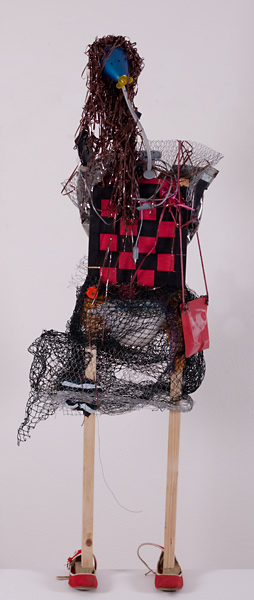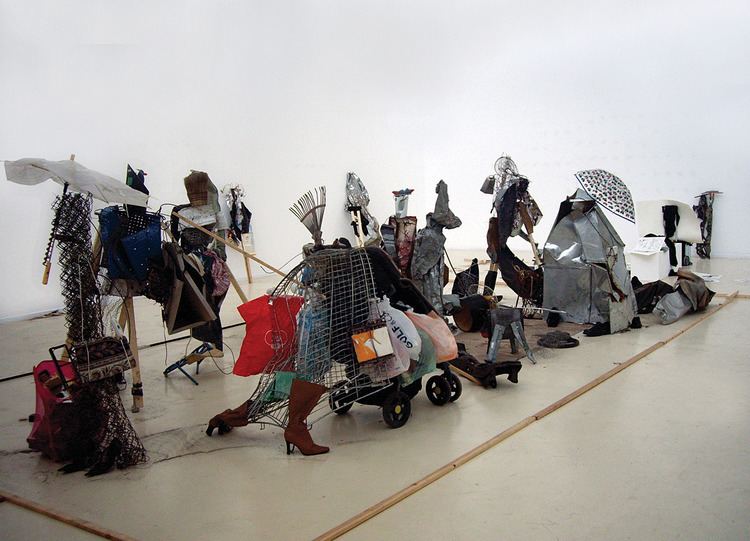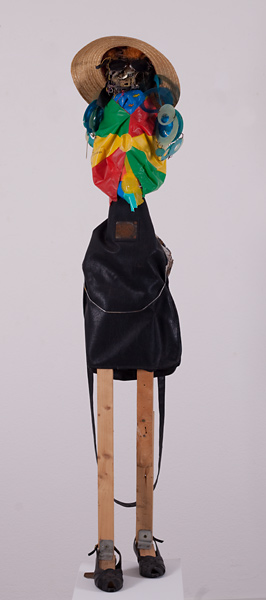
I have equipped myself with in-depth studies in artistic expression, philosophy and anthropology. And with these tools I weave the stories of a people into history for posterity. This is how I make things that don’t sell even if I would have wanted to sell them. No one wants such collective Karmic representations on the living room walls. But museums love such things because they bring in revenue…through projects and programs.
Sanya Osha in conversation with ThejunkmanfromAfrica, also known as Dilomprizulike
A Conversation with ThejunkmanfromAfrica
ThejunkmanfromAfrica (also known as Dilomprizulike) studied fine art at the University of Benin and University of Nigeria, Nsukka, he then proceeds to the University of Dundee, Scotland for his higher degree. He has been a visiting professor at several universities and had apprenticed for two years under the Ghanaian master artist El Anatsui. As this interview would reveal, his work has been exhibited all over the world; Wales, London, Dakar, Bordeaux, Tel Aviv to mention just a few cities. Currently, Dilomprizulike runs the Junkyard Creative Space in Lekki, Lagos, Nigeria. The creative center seeks to foster a wide range of artistic endeavors within the bustling metropolis.
ThejunkmanfromAfrica’s philosophy of art, performance and the mechanics of installation are unique, uncompromising and exceedingly refreshing. Refusing to play by the rules of the commercial art market, he has managed to fashion a formidable aesthetic vision and practice that are at once, bold, irreverently inventive and always full of surprises. The template he has been able to create proves that it isn’t only possible to balk the system but that it is also necessary to “rage against the machine”.
In this conversation he talks about his ups and downs of his journey as an artist.

Sanya Osha: What is the thinking behind the name ThejunkmanfromAfrica?
JMA: ThejunkmanfromAfrica is the one from Africa. There are other artists dealing with junk from other parts of the world but they are not from Africa.
SO: What compelled you to utilize garbage in making art?
JMA: Intent and a sense of duty to conserve, preserve and organize, as I weave the high stories of today into tomorrow’s history, letting used, abused and abandoned objects tell and present their stories in the creative process.
SO: Do you have any artistic heroes who inspired you in this regard? And if so, who are they?
JMA: My father was a smith, repairer and restorer of all sorts of things. As his workshop assistant from the age of five, I watched him repair broken objects, implements and products…objects like umbrellas, cooking pots, buckets and keys. It was into this junkyard that I was born…I literally grew up with junk, so to speak. I also worked as an assistant to El Anatsui, the Ghanaian master artist for two years.
SO: Do you think your work is understood the way you would want by different audiences around the world?
JMA: As in all things, some people understand, others don’t or refuse to. My approach is usually confrontational since it reveals the kinds of human behavior that ought to remain hidden. However, museums find my work attractive since I weave anthropology, philosophy and artistic language into the creative process.

SO: There have been successive waves of artists working with junk. Do you think their work has any relationship with yours? If not, what are the differences between your work and theirs?
JMA: These so-called successive waves of junk artists miss the point of the use of junk as material for art. Their use of borrowed industrial words to describe artistic practice shows it’s all off track. Words like recycling, upcycling and even waste-to-wealth.
Well, as the scramble for breakthroughs and recognition goes on among these young artists who rarely understand the difference between creativity and competition, content takes precedence over context and conceptualization. You see, “these children” have found a toy, but they can only play until bedtime…
SO: Do you have a gallery representing you in Nigeria and abroad? If not, why not? If so, what have been your experiences so far?
JMA: The soup (or scene) is mixed my friend; and the pond is stirred up. Art and artistic practice have been hijacked by business people and speculators within the scene who stuff their pockets at the expense of the role and function of art in society. Half-baked artists fall over themselves with “bleeding” paintings etc. in order to win the “sold out” medal.

SO: How do you negotiate the vagaries of the international art market?
JMA: There’s more market for the “beautiful” things even if unsigned, copied or untitled. Moreover, my work constitutes large sculptural assemblages and installations and therefore not cost-effective for most profit-seeking galleries.
Flexibility is my key factor. Just like every other market, business people are mostly in charge. So, at every point in time, depending on current market factors, I lay out my demands and negotiations can go either way.
SO: What do you consider to be your most impressive international breakthroughs and accomplishments?
JMA: Exhibiting in the world’s biggest museums like the Centre du Pompidou in Paris and many others around the world. As well as participation in biennials and international art conferences. Residencies, workshops and visiting professor at numerous universities have been quite remarkable.
SO: South Africa is a big art market in Africa. Have you been able to make significant inroads into that market? If not, why not?
JMA: Not yet. Maybe marketers will “discover” me one day like Christopher Columbus discovered America as if there weren’t people there before he got there!
SO: Can you talk specifically about some of the art residencies you have been fortunate to be gifted such the ones in Israel, France and the United States? What were they like? What did you learn about yourself, your work and the world generally?
JMA: The residencies were varied in nature, character and formats due to different contextual situations under which they were organized, those that organized them and for whom or by what institutions.
In CCC Barcelona in 2001, I had to co-ordinate and rehearse ordinary volunteers to act the parts of sixteen wearable costume characters I had created to display the powers-that-be as they dictate the appropriation of African sociopolitical life and as they inadvertently affect the lives and fate of our people; like the politician, the pastor, the body-builder, the braggart and his wife, the orange girl and other characters.
It was very successful and the full house audience was clapping and there was a standing ovation for the performance. What none in the audience knew was that the show did not go as planned. Long story short, the ladies were withdrawn at the very last minute because their agent thought it was said to be a fashion show but now these girls were being asked to wear rubbish on a fully lit stage. The show had to go on, so I dressed the men, unrehearsed for their roles in ladies’ clothes and high heeled shoes. The result was ingenious to the audience and victorious for me. What a win-win situation.

In Victoria and Albert Museum in London, I had to look at old culture through clothes and fabrics of the 14th century across the West, stored delicately away from the public. It was agreed that I should develop a conceptual performance from my findings. Well, I enjoyed the numerous accidents that accompanied my entries and authorized my research. But above all, I had armed escort and strong security. This was to me a symbol of the fragile line between the taste of the royalty and the prison yard.
In Tel Aviv, Israel (2009) the Herzilya Museum forgot I was arriving as the staff battled with bureaucracy. So, I decided to assemble junk in the middle of their ‘marble’ floors. But the climax of the confusion and wonderment occurred when the installation “Busy Street” was displayed; the dogs on leaches and their owners on the streets of Tel Aviv and other highlights were evident.
In Lyon (2009), the constitution did not permit the use of garbage from their dumpsites. But ‘the magician’ (my humble self) had to perform otherwise he wouldn’t be paid his honorarium. And so, I bought things from second-hand shops. I then broke them down to make them appear as junk. I had been selected to create a concept that combines traces of socio-psychological elements of society with anthropological-cum- historical values. No wonder ‘the soup’ became watery and yet they still applauded the work.
In Bordeaux, France, a group of artists were invited from five different continents. The organizers of the event claimed all the funds had been spent on bringing over the artists and there was no more money for art projects. As artists, having no choice, we volunteered to work for free as the organizers didn’t have the financial wherewithal to accommodate us properly. We had to make do with crashing at the cribs of the staff.
In Soest, Germany, I took up a public art project to transform 2000 used bicycles into 2000 animals. I put out words through the newspapers in a quest for disused bicycles and I had an enormous response as every inch of space I had was covered in no time. So I went to work. I had barely made 200 figurative animal forms when the city approached me for a public installation project. I was to spread the herd all over the city within a time frame. This had a tremendous effect on the image of the city and the people as well. Individuals were actually looking for traces of their beloved bikes in the installations. When the show was over the forms were stored in front of my studio. A few days later, the whole body of work produced within six months disappeared and I said, “once again, the head of the goat has entered into the goatskinbag”.

SO: How would you say African art is being received in the West over the last few years?
JMA: Africa has a beautiful element of commercial value and so does her art. In this light, African art is usually well received abroad. It had to be, because it became a commodity, packaged and heavily guarded as it fetches a great deal of money through the ages in the museums of Europe. Over the last few years, in the modus operandi of Europeans toward Africa, it seems the continent is still for sale.
So, whether it is about stolen African art works or organized exhibitions and art fares in Europe and the West, or works produced during residencies by African artists, if they don’t sell or bring about political benefits like we are ‘helping’ this ‘poor’ village of a continent, then it isn’t deemed profitable.
As I mentioned earlier if it is not clearly stated, if it has no value, then it has no benefits. So, they watch serious artists, choose the best amongst them and invite them over saying “do whatever you like” knowing fully well that you are being recorded, along with your work ethic, creative abilities and sometimes even your gratitude for the recognition accorded you by the highly placed. After sweating to produce these amazing works you then have to fly out of the country the next day on a 32kg luggage limit. And there aren’t any funds to send your works to you nor a storage for them.
SO: You lost a lot of your work due to theft in recent times. Can you talk about how it happened?
JMA: In Wales (2010), I was offered a three-month residency during which I made an installation that attracted 20,000 visitors in record time. Unfortunately, the director of the program wrote to inform me that they had neither the space to keep the installation nor the funds to have it transported to me. They would therefore have to destroy it!
SO: Since you don’t make commercial art, what is your philosophy of art? Why make something you can’t sell?
JMA: As far as creativity is concerned, I will present myself as a sacrificial lamb to the source of creation as a channel to be used in the Creative Process. Therefore, I do not make art for there is so little that man knows or understands about life, living and creation. So, like a sponge I soak up whichever humanistic tendencies in behavior, attitude and consciousness in any environment I find myself. I have equipped myself with in-depth studies in artistic expression, philosophy and anthropology. And with these tools I weave the stories of a people into history for posterity. This is how I make things that don’t sell even if I would have wanted to sell them. No one wants such collective Karmic representations on the living room walls. But museums love such things because they bring in revenue…through projects and programs.
